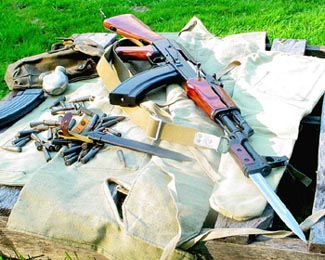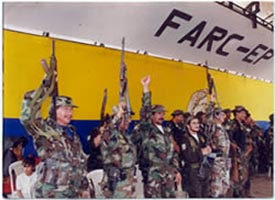 |
International Affairs
Arms for Hugo
Toby Westerman
Russia will begin construction in October of two weapons factories for production of the AK 103 infantry assault rifle in the Latin American nation of Venezuela, officially renamed the Bolivarian Republic of Venezuela by that nation’s present regime.

With Russia's help, Marxist Hugo Chavez will have its own endless supply of AK 130 rifles
|
The AK 47 and its later models are highly regarded for their rugged dependability, and are known as “Kalashnikovs” after the inventor of the original weapon, Mikhail Kalashnikov. The Kalashnikov assault rife has been the staple of the Soviet and Russian military, as well as the weapon of choice of communist guerrilla armies, since its introduction into service in 1949.
The regime of Venezuelan president Hugo Chavez has already purchased 100,000 AK 103s, and now will be able to produce thousands more.
Officials in the U.S. and regional governments are questioning why Chavez needs large numbers of this highly sophisticated weapon. Chavez has assured his neighbors that his nation will not export the AK 103s, and stated that each weapon produced in Venezuela will be stamped with a serial number and the emblem of Venezuela.
American diplomats have urged “transparency” in the production and sale of the weapons.
Hoping that the increasingly Marxist totalitarian nation of Venezuela will conduct its weapons business with “transparency” is most likely an exercise in futility. The history of Marxist regimes from Bolshevik Russia to the present day is replete with the use of self-serving propaganda and misleading statements. Misinformation and disinformation have always been a consistent tactic of communist governments.
In the case of Venezuela, the Chavez regime is reported to have close ties with communist guerrilla groups operating in the region, especially with the Colombian rebel group known as the FARC. The acronym FARC is derived from the group’s Spanish name, Fuerzas Armadas Revolucionarias de Colombia, in English the Revolutionary Armed Forces of Colombia. The FARC has waged a forty-year civil war against the Colombian government, costing tens of thousands of deaths. Ambushes, assassination, kidnapping and involvement in the highly profitable drug trade are hallmarks of FARC activity.
Although Chavez denies any ties with the FARC, official statements issued by the FARC have pledged to come to the aid of Chavez regime if attacked by the United States. Statements from Colombian officials and reports from the regional press also claim that FARC bases exist in Venezuela, and that FARC officials operate openly in Caracas, the Venezuelan capital.

FARC guerrilla men are welcome in Venezuela
|
The guerrilla forces in the region offer a tempting market for the sale of weapons produced by Venezuela. The sale of arms to rebel groups like the FARC would have a particular significance for the United States – and beyond any political importance. The region’s Marxist rebel armies are deeply involved in the illicit drug trade. They protect, and sometimes directly participate in, the production and sale of narcotics which find customers on American streets.
Marxist terror armies directly oppose U.S. efforts to eradicate regional drug production. Three Americans involved in U.S. anti-drug operations in Colombia were in an airplane shot down by the FARC and are currently prisoners of the Marxist rebels.
Chavez and his regime do not, however, have to rely upon clandestine guerrilla groups for the sale of its weapons.
Since Chavez first took office in February 1999, Bolivia, Ecuador, and Nicaragua have elected leaders sharing his vision of “21st Century Socialism,” the “collapse” of the American “empire,” and the revival of communist doctrine in Latin America. Chavez remains close to the regions first communist state, Cuba, and he regards the founder of Cuban totalitarianism as his political mentor.
It is quite reasonable to regard the Chavez regime as a potential arms supplier for the Marxist governments already in power in the region, as well as rebel groups willing to file off serial numbers and insignia from their weapons.
Selling weapons to other nations, as well as to insurgent groups, would be one way to get back some of the $4.3 billion Chavez has already spent on Venezuela’s military build-up since 2005 -- a build-up which includes the most modern jet fighters and missile carrying submarines.
Moscow is Chavez’s main arms supplier.
Chavez sees himself as a new Simon Bolivar, the revolutionary Latin American hero who freed much of the region from Spanish colonial rule. Chavez has officially changed the name of Venezuela to the Bolivarian Republic of Venezuela as a reflection of his belief that he is the new Bolivar, destined to free Latin America from U.S. “oppression.” Moscow is putting the muscle behind Chavez’s anti-American, pro-Marxist rhetoric, and his attempt to build a Latin American communist empire.

Posted August 13, 2007
Toby Westerman publishes
International News Analysis - Today
An investigative, analytical, and uncompromising weekly analysis of the world situation
Contact T. Westerman at
www.inatoday.com
or P.O. BOX 5182, Rockford, ILL, 61125-0182
|
International Affairs | Hot Topics | Home | Books | CDs | Search | Contact Us

© 2002-
Tradition in Action, Inc. All Rights Reserved
|
 |
|